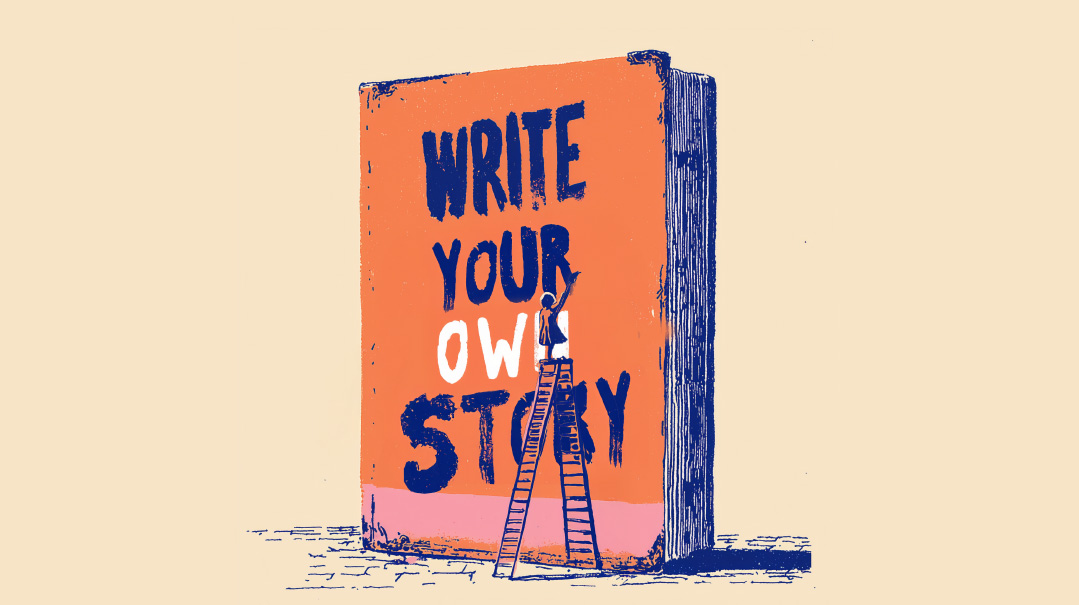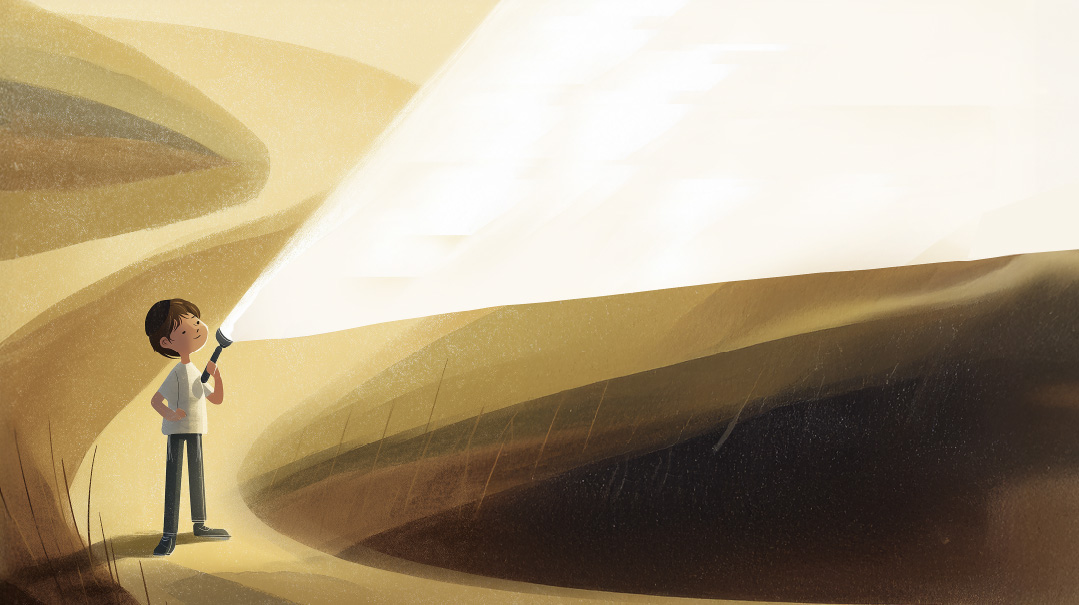No more Copycat Crafts
| November 17, 2015Art isn’t just a fun school activity for children. Its primary goal is to teach foundational skills. But if your kids are just doing the “cookie-cutter” crafts that are pervasive in schools, they may be missing out on crucial development and the chance to discover their own creativity.

huli your seventh child comes home from preschool carrying a paper plate with a gray lump on it and a brown ladder pointing upward. “It’s the stones Yaakov slept on and the ladder from his dream ” she proudly tells you.
Ah right you think parshas Vayetzei is coming. You’ve seen this project before.Leah brought home the same exact ladder last year; Moshe the year before; and Avi two years before that. As a matter of fact you’ve seen the same ladder seven times — and all from different schools. In your basement you have a collection of school projects all nearly identical.
A pile of menorahs each one a replica of the next. Seven Pesach pillows that are so beautiful it’s clear the teacher did most of the work herself. (When you said something to the teacher she replied “But your son did so much! Look how he colored the matzah brown and pasted the fabric Kiddush cup exactly where I told him to.”) There are also seven matching flower projects for Shavuos — the same type of flower the same range of colors. What’s wrong with this picture? Is the problem that these “creative” projects require very little of your child’s actual creativity?
Or that as is the case with some of the more elaborate crafts your child did next to nothing? What about the fact that despite how incredibly different your children are they come home with artwork that is exactly alike?
FLOWERS ARE RED
As an educator for several decades now, I speak from experience when I say that there’s indeed a problem with the way art is typically taught in school. Let me start by telling you about a song from the 1970s called “Flowers Are Red.”
The lyrics tell a story about a little boy who goes to school happily and paints beautiful pictures of flowers, using many colors. His teacher tries to “correct” his error. She explains: “Flowers are red, young man / And green leaves are green / There’s no need to see flowers any other way / Than the way they always have been seen.”
The little boy fights valiantly to keep his creativity alive by saying, “There are so many colors in the rainbow / So many colors in the morning sun / So many colors in the flower and I see every one.” The teacher uses her authority to get the boy “in line” and he ends up painting flowers the way everyone else does.
After some time, the little boy moves to another town. At his new school, the friendly teacher tells him, “There are so many colors in a flower / So let’s use every one.” The song concludes with a sad ending: “But that little boy painted flowers / In neat rows of green and red / And when the teacher asked him why / This is what he said / Flowers are red and green leaves are green….”
Most teachers, thankfully, aren’t as terrible as the one in this song. But many educators today — out of pure ignorance — may be teaching art in a way that restricts, or even crushes, the blossoming creativity of young children.
According to the New Oxford American Dictionary, creativity is “the use of the imagination or original ideas, especially in the production of an artistic work.” With this definition in mind, I ask you: Is a ladder for parshas Vayeitzei a project that opens up a child’s imagination? Is it an original idea?
“COPYCAT” CRAFTS
Avraham’s tent, autumn squirrels, Chanukah dreidels — these all fall into the category of “copycat” crafts, as they’re commonly known. These projects, ubiquitous in most yeshivos and public schools, are:
1) conceived of by grown-ups, and are thus
2) copies of a grown-up’s model, resulting in
3) projects that all look exactly alike, which therefore makes them “copycat” crafts (also known as “cookie-cutter” crafts).
An important note: Copycat crafts are not when children copy each other; it’s when the children copy adults.
Over the span of my career, I’ve seen firsthand the pervasive use of copycat crafts in school. As a preschool teacher, a preschool director, an art teacher, and a workshop instructor for early childhood educators, I’ve encountered teachers of all ages who were so trained in copycat crafts that they couldn’t think beyond that traditional format.
You may be thinking, Okay, fine, so copycat crafts aren’t ideal. But is it worth making such a fuss over them? It is. Art is not just a fun school activity — its primary goal is to teach foundational skills. Here are just a few of them:
- Problem-solving. Once children have a physical grasp of a subject via the use of concrete materials, they can often transfer the knowledge to more abstract ideas later on. (By way of example, I myself never understood adding and subtracting fractions until I was sitting in a “math for teachers” class playing with fractions of shapes and a light went off in my head.)
- Decision making & initiative taking these naturally develop when a child is given a range of art materials (colored tissue, string, tape, etc.) and has to decide which items to use, and in what order.
- Creativity. By cultivating creativity through art, children learn how to think creatively across a span of other subjects.
- Self-esteem. Taking a project from start to finish, creating something beautiful, learning a new way of using a craft material — all of these things help a child develop self-esteem.
Art, as a medium, has the potential to teach so many crucial skills, which is why many teachers fill their students’ days with craft projects. But when — as is often the case — children’s only experience with art is cookie-cutter crafts, there are a number of negative consequences. To name just four:
- Children don’t develop thinking or problem-solving skills
When you’re following step-by-step directions, there’s obviously no thinking involved. Indeed, with copycat crafts, all of the thinking and problem-solving is taken care of by the teacher.
For example: A teacher decides she wants to make a snowman picture with her class. She creates the picture herself, collects the material for the children, holds up the picture and says, “Children, this is what we will be making. Now let’s start with the large circle… next the smaller one, now the scarf, etc.” There’s no room to think here, only to follow directions.
- There is no initiative
When kids are taught to follow directions like robots, they cannot create things on their own. An educational consultant once shared a story that underscores this point: She was taking over for another teacher in a second-grade classroom and decided to give the children an art activity. She gave out paper, glue, markers, etc. and told them they could have some fun. After a few minutes of almost eerie quiet, she looked up. Every child was sitting in her chair not doing anything. When asked why they hadn’t started, their reply was: “You didn’t tell us what to do.” They were so used to being given exact directions that they had no initiative to begin something on their own.
This lack of initiative often follows kids into their adult life. I recently taught an art class for adult women who insisted they had no creativity. One student lamented, “I can’t even draw a straight line.” To make the course very low pressure and fun, I started with abstract art and moved into mixed media and collages.
In one class, I instructed them to make a picture out of various lines (thick, thin, curved, jagged, etc.) using the media we had (such as acrylics, pastels, watercolors). My students just sat there; they were absolutely frozen. They could not handle the nonstructured activity. We laughed about it and I explained what was happening, and that there was no way to make a mistake here. Finally, they got moving. By the time the course was over, creativity was pouring out of these formerly “noncreative” women.
- We don’t get to see where a child is developmentally
Years ago, when I was a preschool director, I would look at the bulletin boards with children’s artwork and was usually able to tell where the children were developmentally.
So, too, in my present job as an art teacher at Ateres Miriam in Far Rockaway. My observations of how the children are creating in art almost always corroborate with how that child is doing in her class.
I once gave a “torn paper collage” art project to a first-grade class. The children had a clear directive: It was to be a snow picture, they could only tear the pieces they needed, and could not use scissors. While you shouldn’t give children a model to copy, they do need some ideas so I always throw out at least five. (Even when I show sample pictures, there are a number of them and the goal is never to copy the picture, but just to use for brainstorming. This way, the child can pick and choose which they want and combine them as well.) To this first-grade class, I said, “This is a winter picture. You can make it snowing, have people in the snow, houses in the snow, snow on cars, snowmen, snow on mountains.”
Below are two results from the same class.
Obviously, I’m showing two extremes here. But, as we can see, children express themselves by creating at the level they are at. The child who created the picture on the right was having issues in her regular classroom and it was expressed in the work she was doing in art.
If we don’t allow our children to create at their own level, we’ll never know what they are truly capable of. We then lose a powerful tool that would clue us in to how our children are developing.
- Self-esteem isn’t fostered
To build self-esteem, children have to feel competent. I have a cousin who vividly remembers the feeling she had in kindergarten when the teacher would hold up a project and say, “This is what we are making today…” Her thoughts, at the tender age of five, were: “Mine will never look as good as that.” When kids feel that they can’t measure up, they often don’t. When, however, they’re allowed to do art at their level, they feel competent and their self-esteem is developed.
Another way children’s self-esteem is built is when they feel like an individual. Imagine walking into a kindergarten classroom and seeing 20 identical cardboard squirrels strung across the room. How good can a child feel when he cannot even tell which of the art projects is his?
REBUTTALS TO RESISTANCE
As a workshop leader on art for early childhood educators, I’ve heard many a teacher rattle off a list of reasons why copycat crafts are important. Some of their arguments:
- The children learn to follow directions through these crafts
- It’s a great way to remember what they learned in school
- It’s necessary for fineimotor coordination
- The kids love having beautiful projects to show off
- This is what the parents want
- Artists learn by copying other artists
For each point, I have a rebuttal:
Learning to follow directions: There are steps to follow for any type of art project (such as the snow picture project above). So why use negative methods (like copycat crafts) to teach positive skills? With art in general, there are many directions to follow. Just think about when children are learning to paint and mix colors. We tell them, “Don’t mix your brush into the other colors, wash it out first, wipe the brush after taking it out of the water, etc.”
Fine-motor coordination: There are hundreds of ways to develop fine-motor skills other than cookie-cutter crafts. To name a few: coloring, painting, sewing, shaping play dough, threading beads, cutting, sticking, scrunching paper, and so on.
Remembering what they learned: This argument never made sense to me because all art can help children remember what they learned, not just copycat crafts. Case in point: The menorah a child makes doesn’t have to exactly match everyone else’s menorah to remind them that we light candles on Chanukah.
Loving how it looks: First of all, just because children like something, it doesn’t mean it’s good for them. (They love candy, going to sleep late, etc.) Also, the “I love showing off my pretty projects!” mentality can lead to perfectionism, i.e., “it’s only good when it looks good.” How many times have I seen children cry and fret because their project didn’t turn out as pretty as the model copy?
The parents want it: Educated teachers make for educated parents, and when you explain the philosophy behind it, parents are usually your biggest advocates.
Artists learn by copying other artists: When artists (or writers for that matter) are copying another’s style, they are learning a skill that they’ll then be able to use for their own creative use. They are learning a skill. A copycat craft is not a skill; it is copying another person’s project before having developed enough confidence in their own abilities. As I’ve seen again and again, copycat projects don’t teach children to be creative on their own. Once children have experienced the kind of art that helps them be creative and think for themselves, then they’ll be ready to learn more skills.
TEACHING ART CORRECTLY
When teachers (or parents) are brainstorming craft ideas, the most important thing to keep in mind is having realistic expectations of the kids. Indeed, cookie-cutter crafts are often an indication that there are unrealistic expectations.
As a prime example, just look at a classroom of really young children (age two to three). They are simply not ready for representational work (i.e., art that actually depicts a recognizable image, such as making a car that looks like a car). If you give these young children craft materials, they’ll usually just make a few little scribbles and cuts, and leave behind a big mess. Teachers are fully aware of this, but they also feel pressure to send home cute projects — and thus cookie-cutter crafts are introduced into the classroom.
We must have realistic expectations: The same way you don’t expect a ten-month-old to talk, you need to wait until these two- and three-year-olds are developmentally ready to create things that you’ll recognize. At this stage, they’re still just learning how to use basic materials like glue, paint, and scissors.
I love to tell the story of what I saw at my daughter’s preschool orientation. I sat down and watched while the children tried out different activities at various tables. A little girl was sitting at a table that had paste and some collage papers. She picked up one piece of paper, applied paste, pasted the piece down… and was finished. Her wonderful teacher came over, picked up the paper, turned it over, and said, “Hey, look, it sticks.” This teacher understood exactly what this child was learning at that point… that glue sticks things to paper.
Process art is how we describe art that concentrates on the process itself, as opposed to the product. This is the type of art that should be taught to very young children. They first need to learn about the materials before they can create anything. As they grow more comfortable with the materials and develop, their work will become more mature as well.
In this experimental stage with materials, teachers (and especially parents) should expect — and accept — that the kids will make a mess. But know that this is a critical and integral part of the learning process. Children need to make mistakes with the materials in order to learn what they can do with them. When children first use glue, for example, they inevitably pour out too much, which indeed makes for a sticky mess. But through trial and error (as well as some guidance from adults), they learn how much glue is needed. When we learn from actual experience, the learning stays with us forever.
I once taught a five-year-old boy who had never been to school before. When he painted, his work was at the level of a three-year-old. But that stage was brief. Before long, this bright child was making representation pictures like the rest of the class. But he first had to go through the stages before settling in at his developmental level. We need the patience to let children be children — and create as children should.
Art is not only for artistic children… or the talented ones who can draw realistically. Everyone has inborn creativity. And I strongly believe that if more emphasis were put on enhancing children’s creativity in the early years, it would transform their entire experience with learning — in and out of the classroom. They would learn better, be less afraid of making mistakes, think out of the box more, have increased confidence in themselves, and would be able to use their creativity in all areas of their lives.
3 Crafts That Inspire Creativity
Chanukah Project
Materials: Paper (any size you choose), glue, scissors, markers (or crayons, oil pastels, etc.). For the collage materials, any number of items can be used: straws, yarn, strips of construction paper, pieces of aluminum foil, sticks, fabric pieces, feathers, pom-poms, etc. If the children are under five, give as many precut strips and items as possible. Older children can be given large papers or pieces of material and cut it up themselves.
Instructions: Show children pictures of many different kinds of menorahs, or bring in real ones. Then explain they can make any kind of menorah out of the available materials. Help them measure or cut as needed. When finished cutting and gluing, the children can use markers (or crayons, oil pastels etc.) to embellish the picture.
Tactile Project
Materials: kosher salt, fat pieces of chalk, small paper plates, paper, glue, markers.
Instructions: Start by describing a desert (you can mention that Avraham and Sarah lived in the desert) and how a desert is filled with sand. Then explain that they’ll be making a sand picture.
To create sand, sprinkle kosher salt onto a paper plate and tell the children to rub chalk into it. The chalk crumbles apart as it mixes with the salt. They can make many colors or just a few.
Set aside the sand and give the children paper and markers with one instruction: draw anything you want. Next, the children will outline the drawing in glue and sprinkle the sand on top, then shake off, so the sand sticks to the glue. If the children are under five or six, they might just use a glue bottle to make designs and then sprinkle the sand on top.
Collage Shape Project
Materials: Sheets of paper, glue, paper cut into various shapes, scissors (in case they want to cut out their own shapes), markers, or crayons.
Instructions: Hold up all the different shapes in front of the class and have a discussion about what the shape makes the children think of. This is to get their imagination going and jog memories. The kids can then make any kind of picture with the shapes provided. When the picture is pasted together, the kids can use markers or crayons to embellish their work.
Note: All projects are for ages four and up. Results will vary greatly according to age and materials provided.
Faigie Kobre is an art teacher at Bais Yaakov Ateres Miriam in Far Rockaway and gives workshops for teachers on how to use art in educationally appropriate ways. She also leads art nights for women and teens.
(Originally featured in Family First, Issue 467)
Oops! We could not locate your form.













